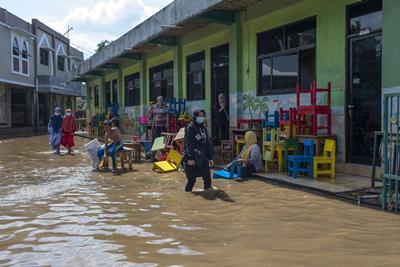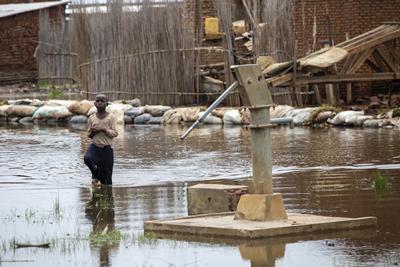
Young people living in the Central African Republic, Chad, Nigeria, Guinea, and Guinea-Bissau are the most at risk of the impacts of climate change, threatening their health, education, and protection, and exposing them to deadly diseases, according to a new UNICEF report.
'The Climate Crisis Is a Child Rights Crisis: Introducing the Children's Climate Risk Index' is the first comprehensive analysis of climate risk from a child's perspective and has been supported by the Data for Children Collaborative, which includes a multi-university team led by the University of Southampton.
The Index ranks countries based on children's exposure to climate and environmental shocks, such as cyclones and heatwaves, as well as their vulnerability to those shocks, based on their access to essential services.
Launched in collaboration with the movement Fridays for Future, the report finds approximately 1 billion children – nearly half the world's 2.2 billion children – live in one of 33 countries classified as 'extremely high-risk'.
These children face a deadly combination of exposure to multiple climate and environmental shocks with a high vulnerability due to inadequate essential services, such as water and sanitation, healthcare and education. The findings reflect the number of children impacted today – figures likely to get worse as the impacts of climate change accelerate.
Henrietta Fore, UNICEF Executive Director said: "For the first time, we have a complete picture of where and how children are vulnerable to climate change, and that picture is almost unimaginably dire. Climate and environmental shocks are undermining the complete spectrum of children's rights, from access to clean air, food and safe water; to education, housing, freedom from exploitation, and even their right to survive. Virtually no child's life will be unaffected.
"For three years, children have raised their voices around the world to demand action. UNICEF supports their calls for change with an unarguable message – the climate crisis is a child's rights crisis."

UK partners on the report are; University of Southampton, which as well as leading and conceptualising the overall project, is leading the development of the measure of child vulnerability – such as poverty, local livelihood types, child education level and child health; University of Edinburgh, which leads on the climate and hazard modelling, including heatwaves, floods, droughts and disease; and University of Stirling, which leads the examination of the global literature on the specific challenges to children of climate change.
Craig Hutton, Professor of Sustainability Science in Geography and Environmental Science at the University of Southampton, comments: "We have an outstanding reputation in research associated with interdisciplinary data analysis, management, and application for nationally and globally significant agencies such as the UN and are pleased to be able to lead this multi-university team in developing a global Children's Climate Risk Index (CCRI) with UNICEF ahead of the COP26 climate conference in November."
The CCRI uses global data sources, such as the World Resource Institute and World Bank, to identify the risk of climate impacts specifically from a child and teenager perspective. This work recognises that children and adolescents have little or no agency in decision making processes and are impacted by climate change in unique ways compared to broader society.
Professor Hutton explains: "Children have particular sensitivities to diseases, malnutrition, and disasters and are subject to the indirect effects of climate change such as migration. As well as producing global maps for 2020, our team will produce more detailed maps for Tanzania and Uganda demonstrating the need to understand child risk to climate in high spatial detail so that differences between environments such as cities and rural areas can be studied."
The Children's Climate Risk Index (CCRI) reveals:
- 240 million children are highly exposed to coastal flooding;
- 330 million children are highly exposed to riverine flooding;
- 400 million children are highly exposed to cyclones;
- 600 million children are highly exposed to vector borne diseases;
- 815 million children are highly exposed to lead pollution;
- 820 million children are highly exposed to heatwaves;
- 920 million children are highly exposed to water scarcity;
- 1 billion children are highly exposed to exceedingly high levels of air pollution [annual mean exposure >35µg/m3]
While nearly every child around the world is at risk from at least one of these climate and environmental hazards, the data reveal the worst affected countries face multiple and often overlapping shocks that threaten to erode development progress and deepen child deprivations.
An estimated 850 million children – 1 in 3 worldwide – live in areas where at least four of these climate and environmental shocks overlap. As many as 330 million children – 1 in 7 worldwide – live in areas affected by at least five major shocks.
The CCRI report outlines recommendations to global governments, businesses and decision makers to reduce the risk presented to children, including:
- Increase investment in climate adaptation and resilience in key services for children. To protect children, communities and the most vulnerable from the worst impacts of the already changing climate, critical services must be adapted, including water, sanitation and hygiene systems, health and education services.
- Reduce greenhouse gas emissions. To avert the worst impacts of the climate crisis, comprehensive and urgent action is required. Countries must cut their emissions by at least 45% (compared to 2010 levels) by 2030 to keep warming to no more than 1.5 degrees Celsius.
- Provide children with climate education and green skills, critical for their adaptation to and preparation for the effects of climate change. Children and young people will face the full devastating consequences of the climate crisis and water insecurity, yet they are the least responsible. We have a duty to all young people and future generations.
- Include young people in all national, regional and international climate negotiations and decisions, including at COP26. Children and young people must be included in all climate-related decision making.
- Ensure the recovery from the COVID-19 pandemic is green, low-carbon and inclusive, so that the capacity of future generations to address and respond to the climate crisis is not compromised.
The second phase of the CCRI project involves using a variety of data variables, such as temperature, flood, disease prevalence and drought in combination with a child relevant vulnerability index that considers child health, food security and education to project 'child climate risk' scenarios forward to 2050.
These projections will be a powerful advocacy tool, helping organisations across the globe better understand the scale and scope of children's vulnerabilities to climate change, and by extension, how to tackle them.






